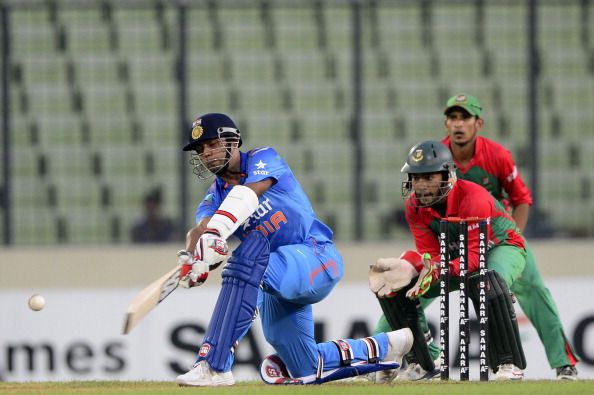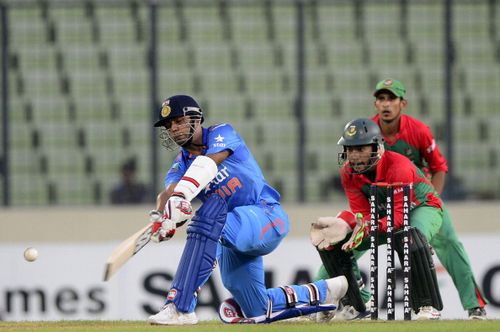
Stuart Binny for the World Cup - A flawed selection?
When Sportskeeda’s cricket experts picked their 15 for India’s World Cup defence, Stuart Binny figured in only one of the squads. While there were talks about his possible selection, it did come as a surprise to most cricket lovers across the country.
Also read: Stuart Binny: 10 facts you need to know about the Indian all-rounder
It should be made clear at the onset, that there is no mala fide intent in this article, but simply a few questions that must be answered no matter what. And it would be delightful if Binny proves all his detractors wrong and helps India retain the World Cup, but from what we have seen of him, that happening is unlikely.
It’s fair to say that there’ll never be a perfect selection, no matter what. But the idea is to minimize the imperfections as far as possible.
Binny, the all-rounder
Binny was drafted into the Indian ODI team for the tour to New Zealand in early 2014. He was seen as the seam bowling all-rounder – a military medium pacer, doing a role that Sourav Ganguly often did for the Indian team and with much success. While Ganguly’s batting was a league above Binny’s, it was believed that in ODIs and Tests, Binny could be as efficient as the former India captain, containing the batsman, bowling stump to stump, at around 120 kmph – while picking up wickets at the same time.
But what one missed was the fact that even Binny’s selection into the ODI setup was largely based on how he impressed during his stints in the IPL and not his domestic performances alone. The only domestic competition that selectors could look at before drafting Binny in, would be the 2013/14 Ranji Trophy, as the preceding Vijay Hazare Trophy was played almost ten months before Binny got selected.
In this particular edition of the Ranji Trophy, Stuart Binny scored 321 runs at an average of 40.12, with a century and a half-century to his name. With the ball in hand, he picked up 11 wickets at 37 a piece. At first look, the figures look impressive, especially considering that he played for a competitive team like Karnataka, against competitive opposition like Mumbai and Delhi.
Comparing Binny to other all-rounders in domestic cricket
In fact, the other all-rounder, who was overlooked for Binny’s inclusion was Himachal’s Rishi Dhawan. Dhawan, who impressed all while playing for Kings XI Punjab in 2014, had 435 runs to his name at an average of nearly 40, with five half-centuries. While bowling, Dhawan was dangerous, picking up 49 scalps at an average of just over 20, with six 5-wicket hauls and one 10-wicket haul. He was the highest wicket-taker of the tournament.
The strongest supporting argument for Dhawan’s detractors has been how he has performed against relatively weaker teams like Andhra Pradesh, Assam and Tripura. Thereby putting him at a disadvantage, when compared to Binny, whose performances have come against domestic powerhouses. Although this seems like a plausible explanation, it perhaps isn’t, as not every bowler from the so-called weaker group picked up as many wickets or scored as many runs as Dhawan did. And even if we are to believe that Dhawan performed against weaker teams, it would be hard to justify Binny’s selection vis-a-vis the other seam bowling all-rounders’ during the same domestic season.
Unless of course, selectors and fans alike are hell bent upon using IPL performances as a metric to justify Binny’s selection in the Indian team, making it a completely different discourse altogether. During the Ranji season being spoken of, and in a group that was shared by Karnataka, Delhi’s Rajat Bhatia scored 492 runs at an average of 54.66, along with the 8 wickets that he took at an average similar to that of Binny’s.
While representing his IPL franchise, Bhatia put up decent shows consistently but was overlooked. In Group B, Bengal’s workhorse captain, Laxmi Ratan Shukla scored 608 runs at an average of 46 and picked up a wicket more than Stuart Binny for similar runs per wicket. Unlike Dhawan, Shukla played against stronger teams like Uttar Pradesh and Tamil Nadu.
Dhawan at 23, had age on his side, but not experience. Bhatia and Shukla at 31 and 32, respectively, had experience on their side but not age. Binny, it seemed, was the ideal choice. After all, he was a year younger to Bhatia. Selectors forgot that countless times, in their domestic careers, Bhatia and Shukla have done remarkable acts in rescuing their teams from pressure situations with both bat and ball, clearly a separate yardstick was used to evaluate them as opposed to the one used for Stuart Binny.
Does Dhoni trust Binny?
In India’s desperation to find another Irfan Pathan, Binny benefited the most. A person, who till just a few years back was on the fringes of his state team, now had six ODIs and three Test caps to boast of. He made his debut against New Zealand in early 2014, and in the very conditions which was given as a justification for his World Cup selection, the captain didn’t trust him enough to do the job for the team. It made one wonder why an ODI cap was given to a player, if all that was expected from him, was a solitary over?
Later that year, Binny stunned the world with six wickets for a miserly four runs against a clueless Bangladesh batting line-up in Dhaka. Not only did he figure in the record books after that terrific spell, he also ensured that he picked up two-thirds of his entire wickets tally in international cricket.
In a month’s time, he got his Test cap at Trent Bridge. He got two more caps, at Lord’s and the Oval. In the three games, he bowled 32 overs with no wicket to show for, and leaked runs at above four runs per over. Mind you, these were conditions that supposedly helped his type of bowling. Ask Paul Collingwood. Ask Ganguly. To his credit, Binny scored a match-saving 78 in his debut Test.
World Cup calling
After his show against Bangladesh, Binny added just three wickets to his career tally. Two in an ODI against Sri Lanka in Kolkata, where he went for nearly seven runs an over and one in the following game against the same opposition in Ranchi. But the 6/4 ensured that his bowling average remained at par with his batting average, i.e. 13. Remove that one freak performance, his bowling average plummets to a near forty mark.
But why blame a player for being the most suitable amongst the pool available for selection? After all, it’s not his fault that he was drafted in, in the absence of any worthy competitor. Also, former cricketers like Rahul Dravid and Sunil Gavaskar, and pundit, Harsha Bhogle have advocated for his selection, emphasizing on Binny’s utility in New Zealand, just like his utility in England was harped upon while handing him three Test caps.
It’s never easy to dismiss players who have scored more than a combined 20,000 Test runs for their country, and to some level they could be right. But whether Binny’s selection was meritocratic could be explored in the following section, thereby, analyzing the merit in Dravid-Gavaskar’s pick.
A selection that warrants merit?
Games in New Zealand
It’s been said countless times that places in New Zealand, where bowlers get lateral movement, are a perfect setting for Binny to display his craft. But let’s get it straight, India get to play only two games in New Zealand, that too against less formidable teams like Zimbabwe and Ireland. The World Cup seedings are such that if India clear the league stage, irrespective of their standing, their knock-out games would be played in Australia.
Since Binny isn’t the kind who would hit the deck hard or extract bounce from the surface, his utility in Australia is marginal. So it brings us to the unmissable fact, that a Stuart Binny is what India desperately needs to cross the line against Zimbabwe and Ireland, in a form of cricket where they are currently ranked second.
Need for an all-rounder
Now that we know that the condition, for which Binny has been selected will occur only twice in the one and a half month long event, one needs to envisage the possible India line-up.
Shikhar Dhawan, Rohit Sharma, Ajinkya Rahane, Virat Kohli, MS Dhoni, one out of Ravindra Jadeja and Akshar Patel, Ravichandran Ashwin and three fast bowlers, with Bhuvneshwar Kumar definitely being one of them. So there’s a Test centurion batting for India at 8, with a first-class centurion to follow. If nine solid batsmen can’t win you games, can that additional all-rounder do the job?
The next question would be whether India see Binny playing in place of Jadeja and Patel. And seeing Dhoni’s fondness towards controlling the middle overs and stifling runs using spin, it is highly unlikely that he would opt for Binny at the expense of a spinner, unless of course, conditions are heavily tilted in Binny’s favour (as we discussed previously). So the seam bowling all-rounder will seldom be used, and will be performing a duty that Bhuvneshwar can easily perform. Most alarmingly, he will be occupying the place of a frontline batsman or a frontline bowler.
An injured force
Bhuvneshwar has just returned from injury, with Ishant Sharma is rested for the Sydney Test. Umesh Yadav and Mohammed Shami have experienced a long grueling Test series in Australia, with the one-day leg to follow.
In the event of a possible breakdown, India will be left with only three frontline pacers to choose from. And God forbid if anyone of them is out of form, India will be compelled to play him as Binny will not be able to take the place of a frontline bowler with the skills that he currently possesses.
Neither a bowler nor a batsman
The World Cup is the pinnacle of cricketing events that we are talking about and not an annual domestic T20 competition. In such a scenario, it's hardly plausible to field a player who can’t single-handedly win you matches, either with the ball or with the bat.
Binny’s List A bowling average is in the 30s, with an economy on the higher side. With the bat in hand, he doesn’t cause any concern to the opposition either – average in the early 20s, with a large part of his games being played in the batting friendly pitches of India.
The bigger question
Binny’s selection might not be a case of a father pulling his strings. Roger Binny is an honourable man. So are Gavaskar and Srikkanth, and sadly none of their sons could make use of the opportunities that they got. Hence, the controversy theories floating around social media should be sidestepped.
However, it is indeed true that a large part of Binny’s selection has been based on his IPL performances alone, where the performances of quite a few of the others have been conveniently ignored citing lacklustre performances in the domestic circuit. In that case, a lot of domestic performers’ feats have been ignored citing lack of exposure to pressure situations in the IPL.
So where does one eventually go? Unless there is more clarity on what selectors are looking at, we might never know. But right now, the focus should move beyond whether India have done a good job by omitting X, Y or Z. The bigger question should be whether Stuart Binny’s credentials are good enough to warrant a place in the fifteen. He can’t replace a specialist batsman, neither can he fill in for a specialist bowler. He can’t impact the result of the match like Yuvraj or Irfan Pathan, in their prime could. So why is he there?
(With invaluable inputs from Siddartha Khandelwal)

